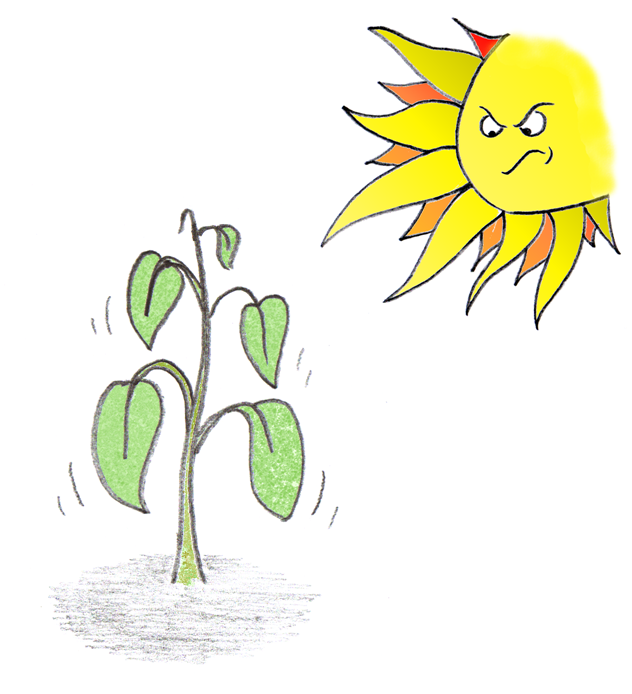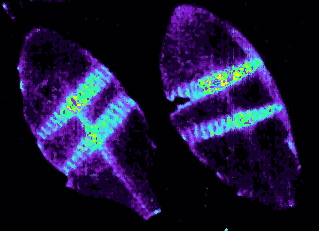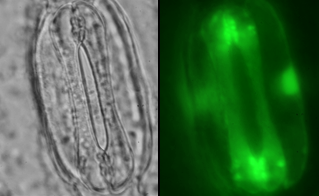Mike Roberts
Plant Stress Biology

Plant Interactions with the Abiotic Environment
As well as my main focus on plant defence against pests and pathogens, I am also interested in plant abiotic stress tolerance. I am involved in projects searching for new fundamental understanding of plant stress signalling mechanisms and in more applied projects aimed at solutions to ameliorate plant abiotic stress.
Ozone Stress

I am involved in a project led by Martin McAinsh to investigate plant responses to ozone, a damaging atmospheric pollutant the levels of which are likely to rise with global warming.
We have identified transcriptional regulatory networks in Arabidopsis which control ozone-induced changes in gene expression via the generation of a characteristic calcium signature. Read more...
More recently, we have begun a collaboration with Julia Davies at Cambridge to investigate the role of the Annexin 1 protein in ozone signalling. ANN1 functions as an ROS-sensitive calcium channel in Arabidopsis, and ann1 mutants fail to generate the characteristic ozone-induced calcium signature.
Light regulation of the Arabidopsis wound response
 Around ten years ago, we made the fascinating observation that wounded plant tissues emit light. We now know that this spontaneous
bioluminescence is caused by oxidative damage to membrane lipids.
Around ten years ago, we made the fascinating observation that wounded plant tissues emit light. We now know that this spontaneous
bioluminescence is caused by oxidative damage to membrane lipids.
We subsequently found that the bulk of wound-induced ROS are generated in the chloroplasts by disruption of photosynthetic electron transport.
We also showed that darkness significantly attenuates the transcriptional response to wounding, and identified a number of genes whose wound-induced expression is light-dependent and appears to be controlled by chloroplast-derived ROS. Read more...
Stomatal Regulation in Cereals
Stomata are the pores in the surfaces of plant leaves that allow gas exchange between the leaf and the atmosphere. They are therefore critical in controlling water and nutrient transport via transpiration, and the uptake of CO2 for photosynthesis. The degree of opening of stomata is regulated by turgor changes in a pair of guard cells which border the pore.
 Guard
cell responses to a range of environmental signals which control
stomatal apertures have been characterised in great detail over the past
few decades. Almost all of this work has been carried out in species
possessing stomata bordered by guard cells which have a characteristic
'kidney bean' shape. Cereals such as maize, rice, wheat and barley,
which comprise the major food crops worldwide, possess guard cells with
a different anatomy, however. Cereals possess 'dumb-bell'-shaped guard
cells which have different mechanical properties in respect to their
ability to open and close in response to turgor changes.
Guard
cell responses to a range of environmental signals which control
stomatal apertures have been characterised in great detail over the past
few decades. Almost all of this work has been carried out in species
possessing stomata bordered by guard cells which have a characteristic
'kidney bean' shape. Cereals such as maize, rice, wheat and barley,
which comprise the major food crops worldwide, possess guard cells with
a different anatomy, however. Cereals possess 'dumb-bell'-shaped guard
cells which have different mechanical properties in respect to their
ability to open and close in response to turgor changes.
We have developed a bioassay cereal which has enabled us to begin to characterise the responses of barley guard cells to key stimuli relevant to environmental change, such as CO2 levels, temperature and the plant hormone abscisic acid (ABA) which regulates drought stress responses.
Crop Stress Protection using Plant Activator Compounds
An important outcome of science that seeks to understand plant tolerance to abiotic stress is to convert that understanding into solutions for crop protection. Plants typically have a greater capacity for stress tolerance than is expressed under commercial conditions, perhaps because breeding programs have focussed on other traits. Techniques that exploit natural plant stress tolerance mechanisms have potential as sustainable solutions to protect against losses due to abiotic stress.
We have been using plant hormones such as jasmonates and other natural plant products as so-called 'plant activator' compounds to help develop and validate new commercial products in partnership with companies such as Plant Impact plc.
See our 'Impact' page for more information.
